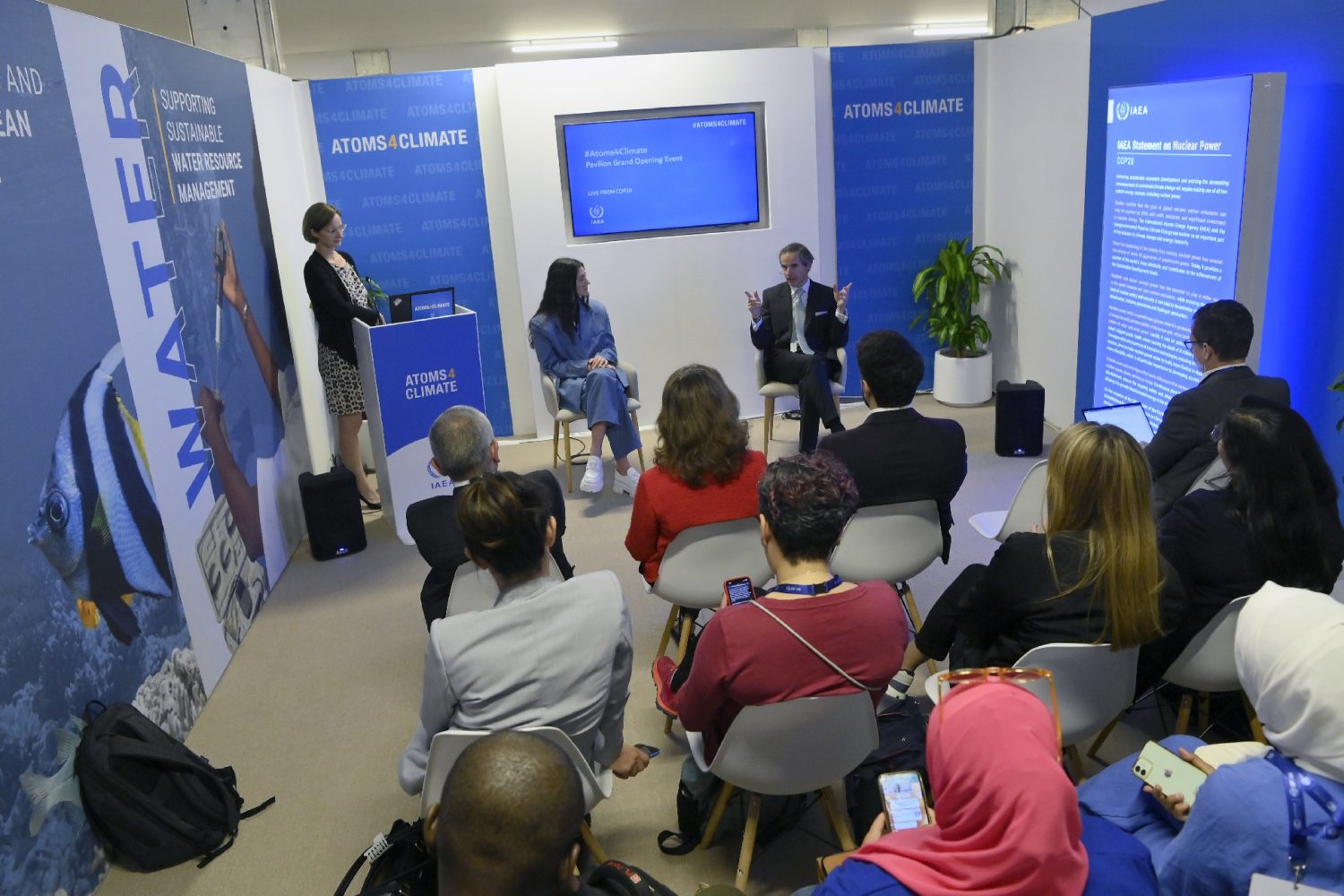
The Reactor Future At a Glance
back to contentsAhead of the COP28 conference, the IAEA released its Nuclear Technology Review 2023 report covering the key events of 2022 and the trends that the agency’s experts believe will shape the future of the global nuclear industry.
The review outlines 26 aspects defining the latest industry developments and trends. We will consider the most significant and interesting of them below.
Nuclear capacity additions
For the second straight year, the IAEA has revised its outlook for global nuclear generation upwards. The installed nuclear capacity could increase to 873 GW by 2050 in the high case scenario, up 10 % from the previous year’s high case projection. The share of nuclear power could therefore grow from the current figure of 9.8 % to 14 % of the global electricity mix. For this scenario to come true, systemic transition to long-term operation through life extension would be required across the existing fleet and nearly 600 GW of new capacity would need to be built in the coming 30 years.
Rosatom makes a substantial contribution to this goal. The Russian nuclear corporation is building 22 power units in seven countries, with a total of 33 units in 11 countries in the pipeline. For 18 years since its foundation, Rosatom has built 18 large power units, including nine reactors outside Russia. Fresh nuclear fuel has been delivered to the Akkuyu NPP in Turkey and the Rooppur NPP in Bangladesh this year.
According to the report, financing new-build nuclear capacity remains a challenge, though some positive developments are on the way: in 2022, nuclear power was included in the European Union’s sustainable finance taxonomy, as well as in other taxonomies around the world. In general, the IAEA notes an improvement in the policymakers’ attitudes toward nuclear due to its input into the reliable supply of low-carbon electricity. Turkey and Egypt, where nuclear power plants are being built by Rosatom, have included nuclear power in their national contributions to a carbon-free future under the Paris Agreement.
Small modular reactors
Interest in small-scale nuclear generation is one of the latest trends outlined by the IAEA. “Together with advanced large water cooled reactors, SMRs are expected to make up the bulk of capacity additions over the next three decades,” says the report.

Rosatom was the first in the world to commission a floating nuclear power plant, the Akademik Lomonosov, and proceeded with another three SMR projects. The first of them is the construction of four offshore power reactors to supply electricity to the Baimsky GOK mining site. The second one is an onshore small-scale nuclear power plant in Yakutia. These two projects will use RITM‑200 reactor technology in various modifications. Besides, Rosatom is working on the construction of a small NPP with a Shelf-M reactor, which will supply power to the Sovinoye deposit and adjacent ore fields. All in all, Rosatom is developing about ten reactor designs for small-scale nuclear power plants. Discussions are underway between Rosatom and governments of other countries, particularly Mongolia and Myanmar, on the construction of small modular reactors.
New technology
As noted in the report, several countries are increasingly considering, studying and implementing advanced versions of existing water-cooled reactors for the gradual deployment of advanced and more efficient partially or fully closed fuel cycles: “In the Russian Federation, conceptual studies on innovative water cooled, water moderated power reactors of supercritical pressure are ongoing, including the possibility of a fast-spectrum core. The recent designs are focused on small modular versions […], emphasizing enhanced safety, security, economics, and sustainability.” In addition, Rosatom has entered an advanced development stage with a spectral shift control reactor VVER-S (we wrote about it in our previous issue).
Molten salt reactors are also named in the report among promising coolant technologies. This technology is pursued by Rosatom as well, but not for power generation purposes. A research reactor with molten salt as a coolant is intended to pilot a transmutation technology for minor actinides to obtain less radioactive fission products. The reactor is scheduled to go critical in 2030.
A separate section of the report is dedicated to fast neutron reactors. There are five sodium-cooled fast neutron reactors in operation worldwide: one is located in China, another in India, and three are situated in Russia. Rosatom plans to build another fast sodium-cooled reactor, BN‑1200, with a capacity of 1200 MWe. The first concrete for the reactor is scheduled to be poured in 2027. Another sodium-cooled fast-neutron unit — a 150 MWe multi-purpose research reactor MBIR — is now under construction.
Technologies employing heavy liquid metal as a coolant are attracting increasing interest. Rosatom is also ahead of the curve here as it is the first in the world to be building a pilot lead-cooled fast neutron reactor, BREST-OD‑300, with a capacity of 300 MWe.
Non-electric applications of nuclear ower
The Nuclear Technology Review names the generation of heat (independently or in co-generation with electricity) for district heating or commercial purposes, water desalination and hydrogen production as the most promising non-electric applications of nuclear power. Rosatom is active in all these areas, too. For example, Akademik Lomonosov in Chukotka supplies the nearby town of Pevek with heat. A desalination plant designed and manufactured by Rosatom is being installed at Akkuyu to provide water for reactors, sanitary, drinking and firefighting needs. The Kola Nuclear Power Plant plans to launch a test bench facility for the production of hydrogen by electrolysis. More than that, Rosatom is working on the design of a 200 MWt high-temperature gas-cooled reactor combined with a hydrogen production plant with an annual capacity of about 110,000 tonnes. The first unit is expected to be built in 2032.
Natural uranium
The IAEA experts quoted global forecasts in their review, indicating that uranium demand over the next five years would increase from about 160 million pounds of U3O8 per annum to about 190 million pounds. “In anticipation of further increases in the spot price for uranium, it is predicted that NPPs’ procurement departments will be looking to forward purchase uranium ore concentrate and to develop once again long-term contracts with uranium suppliers. This has the potential to further increase the spot price for uranium, which is expected to increase from about USD 52.00/lb U3O8 to about USD 65.00/lb U3O8 by 2027,” says the report. Reality has outperformed the forecast for now: the spot price as of December 4, 2023 was USD 81.45/lb.
“It is anticipated that new uranium mines will open in the next five to ten years, including in Australia, Brazil, Canada, Mauritania and Namibia. However, forecast production from these new operations will not be sufficient to make up the supply gap that is currently filled with secondary sources. As such, it is anticipated that exploration activity for uranium will increase in the coming years, including in conventional and unconventional deposit types,” IAEA experts predict.
It should be recalled, Rosatom is developing deposits and conducting explorations in Russia and Kazakhstan, and has mining projects in Tanzania and Namibia.
Fuel
The following trends were identified by the IAEA experts in the fuel segment: improvement of fuel safety for the existing large-scale reactors, development of accident tolerant fuels, higher burnup and enrichment, and extension of fuel cycles through higher average burnup.
Besides, new reactor designs require the development of advanced fuels. “[…] HALEU (high-assay low-enriched uranium enriched up to 20 % in U‑235 — RN) will be required to manufacture many of the innovative nuclear fuel concepts,” says the review. The United States has plans to establish a HALEU infrastructure for advanced reactors, but currently only the Russian Federation has a supply chain for HALEU fuel production.
Rosatom is working systematically on developing new fuel compositions and structural materials to make nuclear fuel safer and more cost-efficient. Fabrication technologies for the new — composite in particular — cladding materials are being studied to improve fuel performance. For example, composite silicon carbide cladding samples passed the first stage of in-pile tests in the BOR‑60 research reactor earlier this year.

Development of new methods for the spent nuclear fuel (SNF) management and disposal is becoming increasingly important. Rosatom’s activities cover several areas in the SNF segment. The first of them is the fabrication of new fuels from SNF. These are primarily mixed uranium oxide (MOX) and uranium-plutonium fuels. For example, the BN‑800 reactor has been operating for a year now with a core almost fully loaded with MOX fuel. Rosatom is also working to obtain commercial quantities of mixed uranium-plutonium nitride (MUPN) fuel.
Second, the Russian nuclear corporation is developing the concept of a balanced nuclear fuel cycle, which provides for SNF reprocessing, extraction of valuable components and subsequent transmutation of the most radioactive elements (minor actinides). The transmutation concept has reached the in-pile testing stage. In December, the first three fuel assemblies with MOX fuel containing minor actinides, americium‑241 and neptunium‑237, passed acceptance tests at the Mining and Chemical Plant (part of Rosatom’s fuel division). The fuel assemblies will be loaded into the BN‑800 reactor at the Beloyarsk NPP in the spring of 2024. As expected by the researchers, americium and neptunium will be bombarded by fast neutrons and decay into lighter elements, which will have lower radioactivity and shorter half-life than the original isotopes.
Third, Rosatom is developing methods, tools and techniques for the safe management of various types of spent nuclear fuel and radioactive waste, applying them effectively in nuclear legacy management. These efforts have been taken successfully for many years, for instance, in the northwest of the Russian Arctic.
Fourth, Rosatom is deploying infrastructure for the ultimate disposal of spent nuclear fuel and radioactive waste. Finally, Rosatom is involved in many rehabilitation initiatives at former mining sites. One of such initiatives was completed this autumn at the former Taboshar uranium mine in Uzbekistan, the first in the USSR, where mining operations started in the middle of the last century.
Summing up the above, Rosatom’s activities are not only in line with, but in many cases at the forefront of, the nuclear industry trends.




